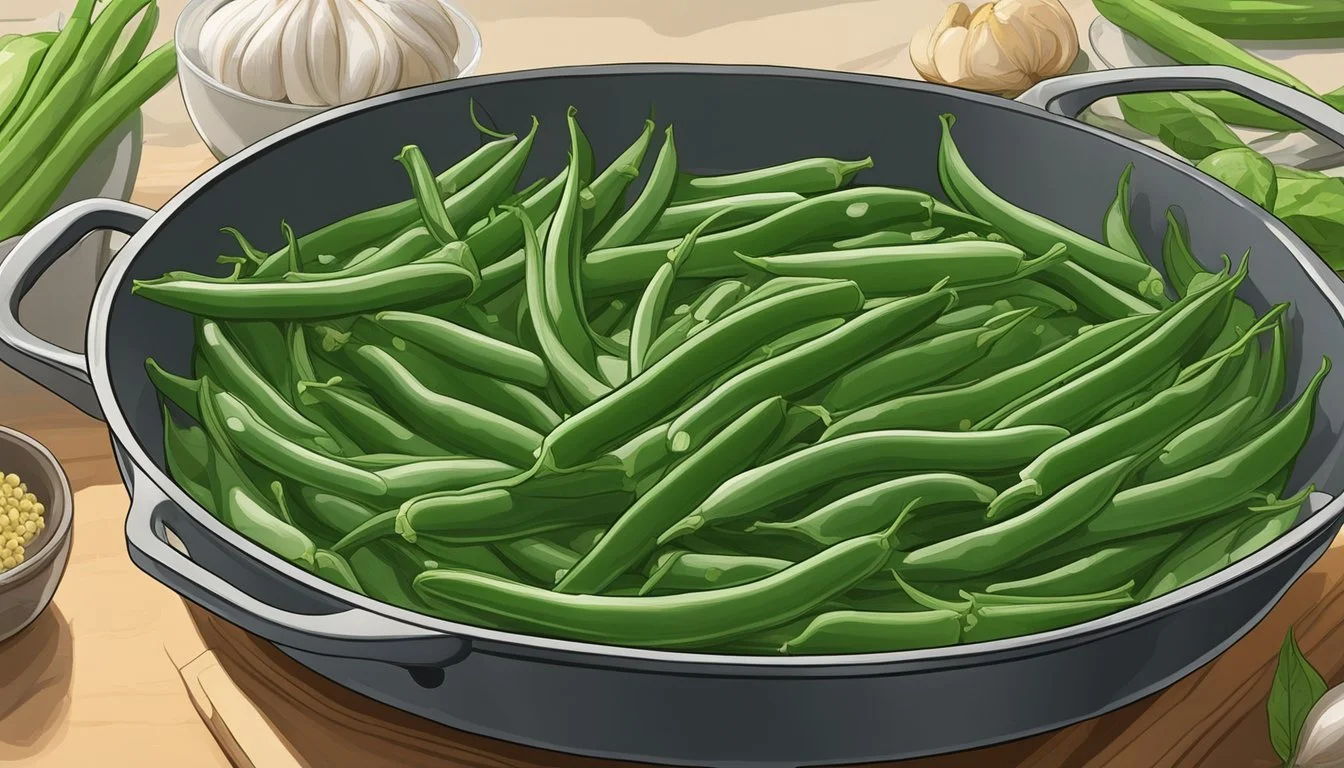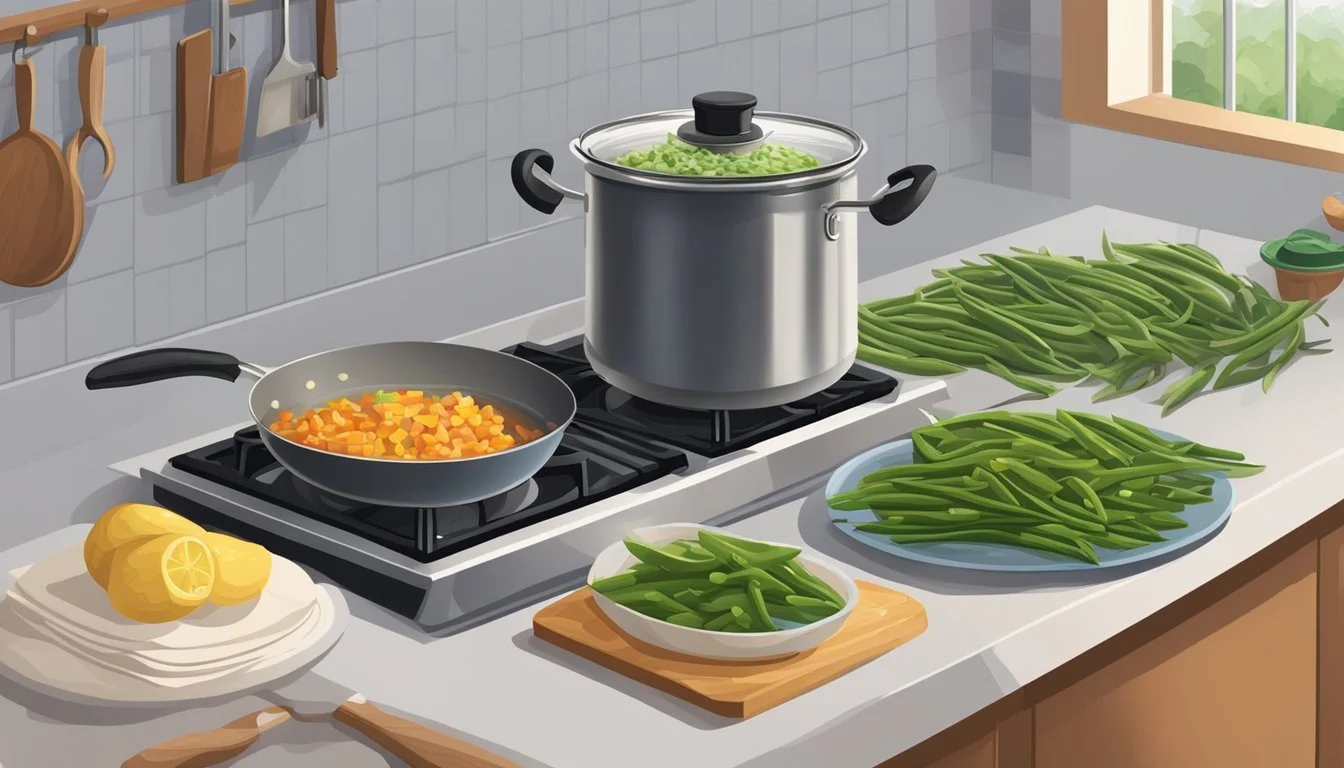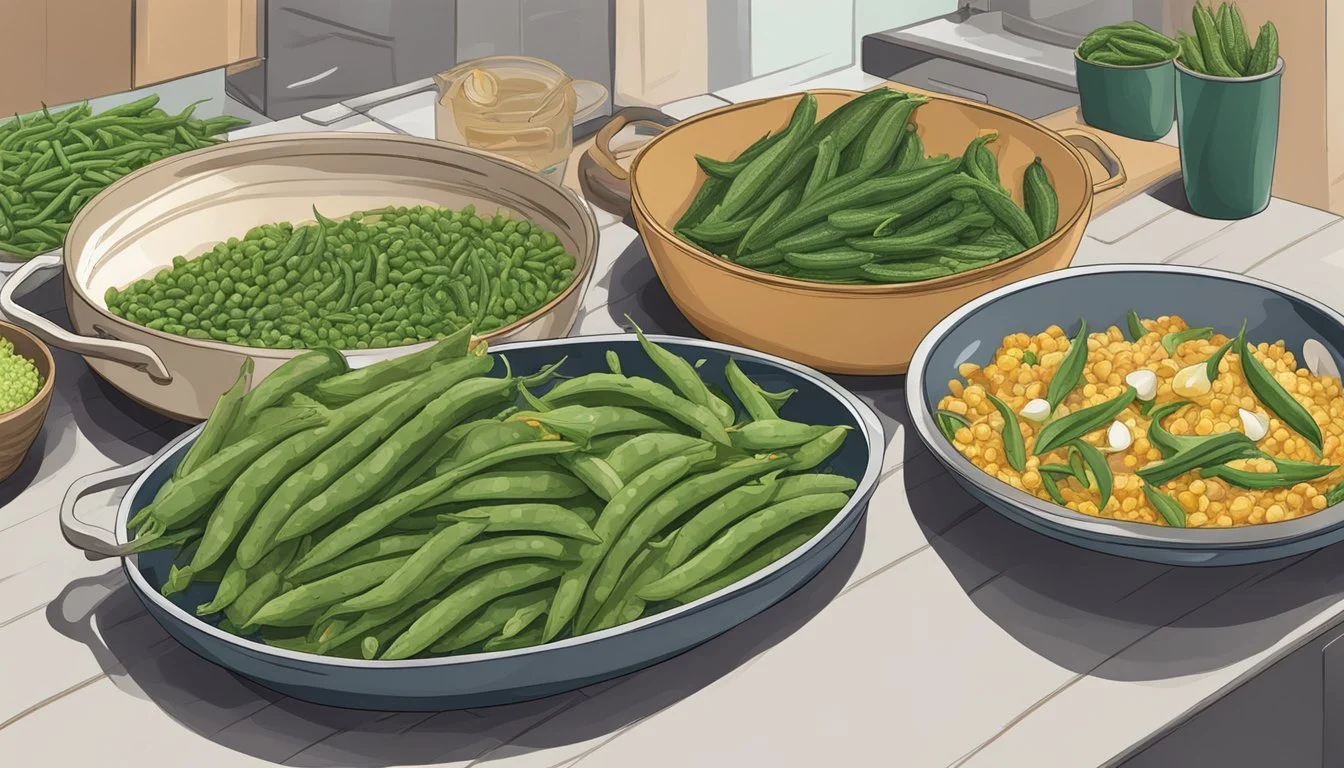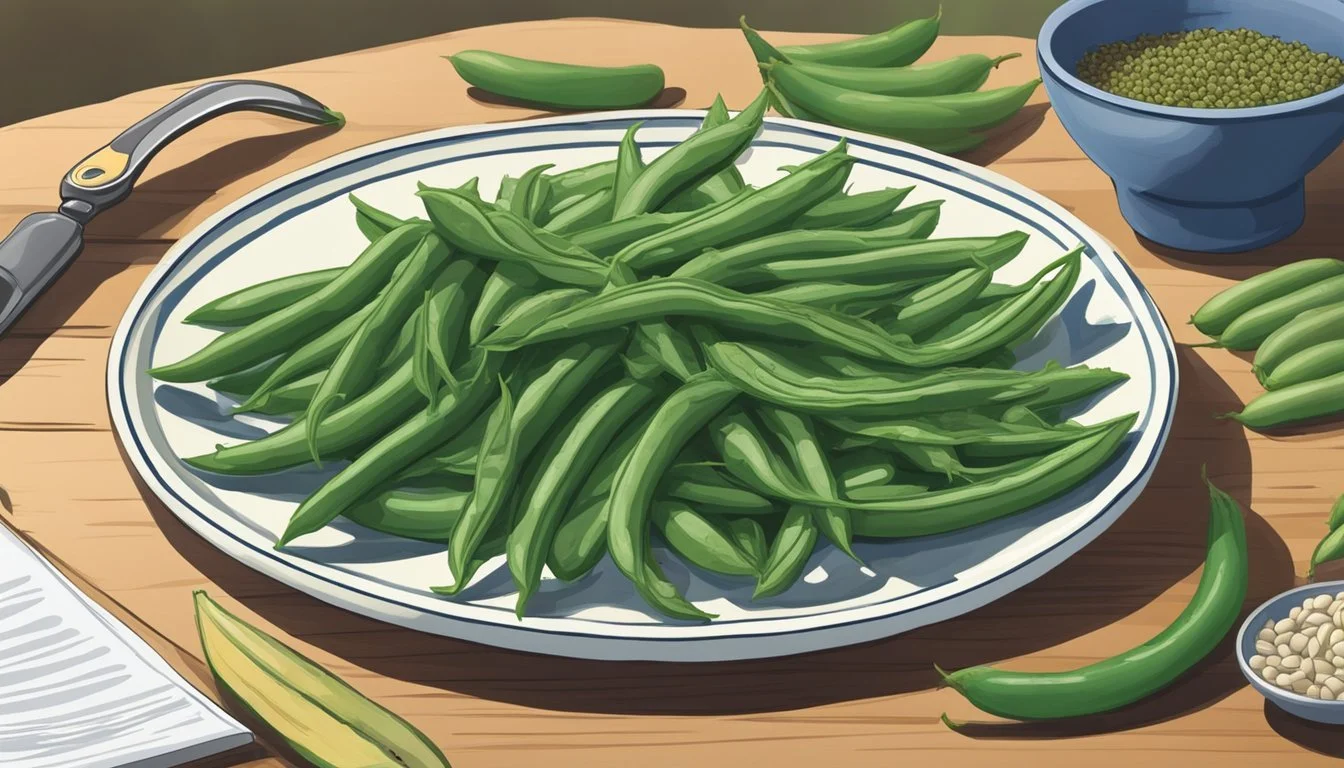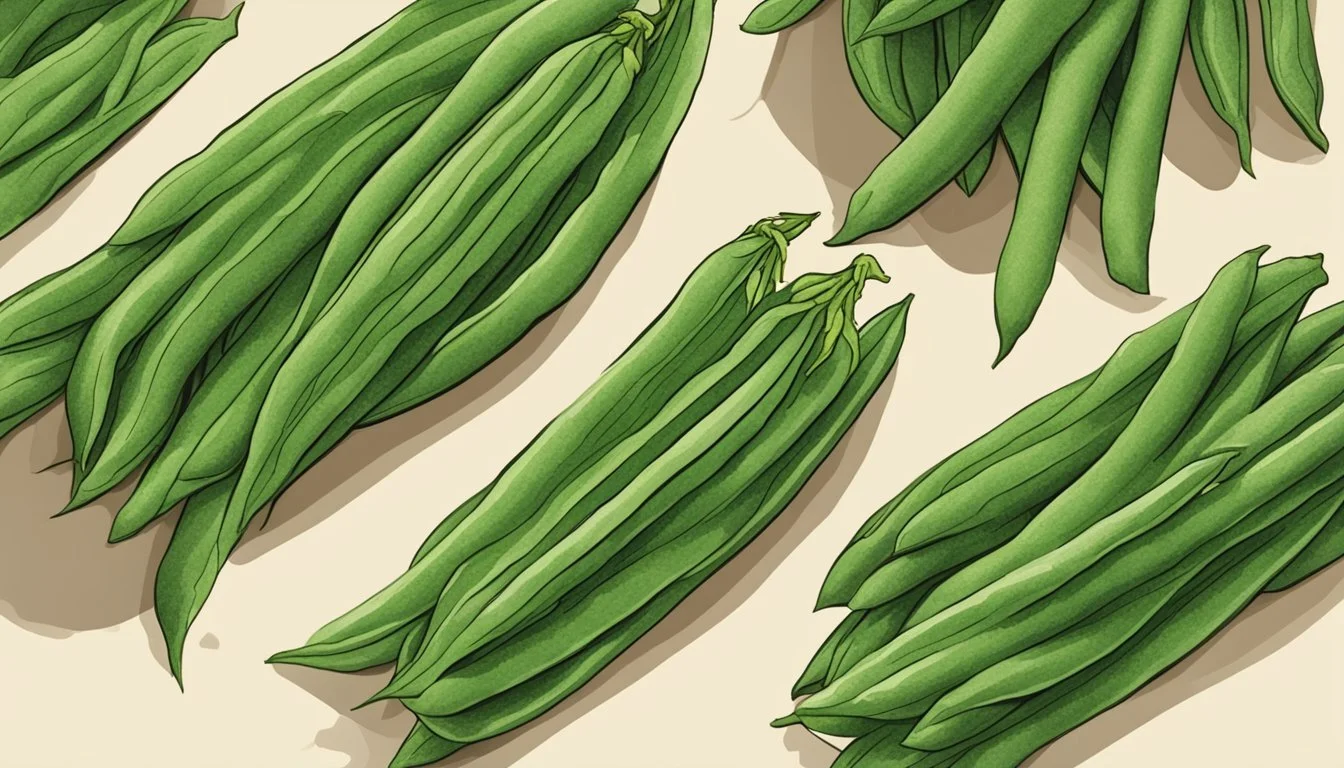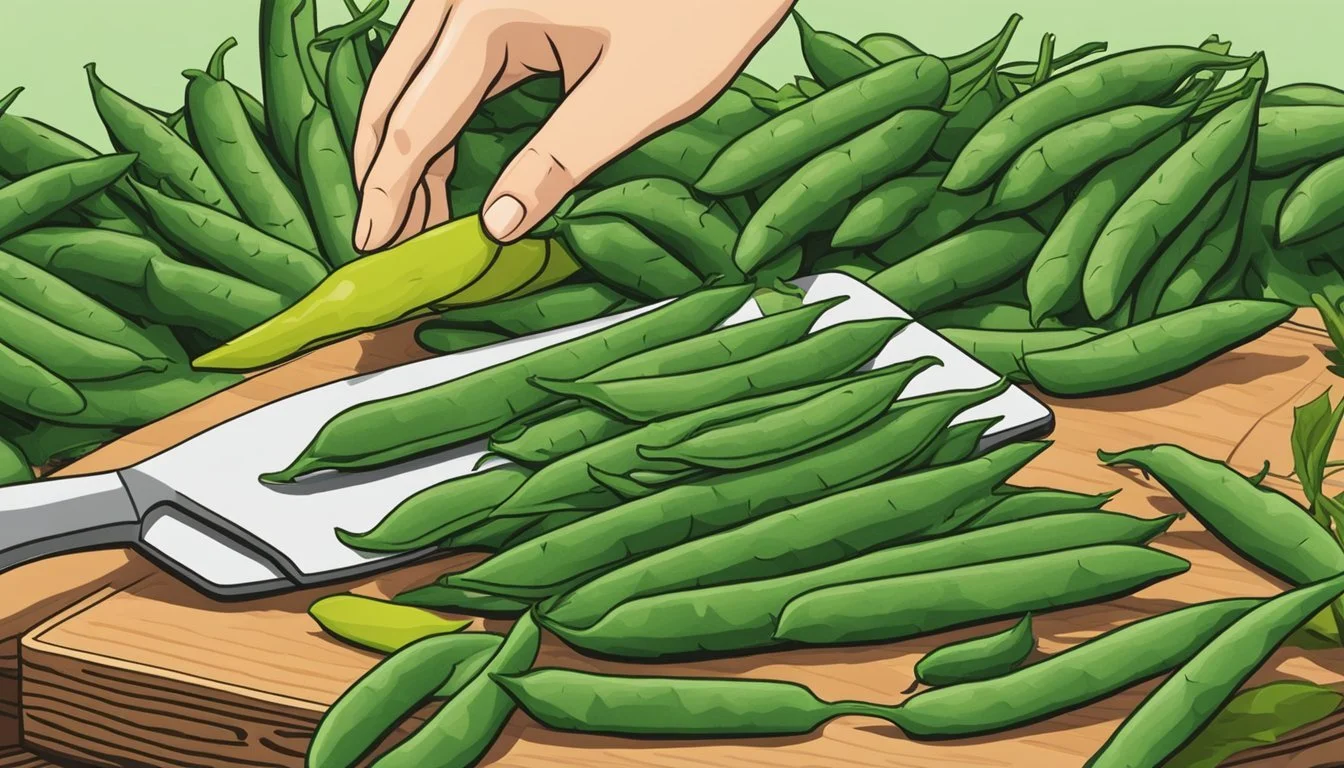How to Substitute Nopales for Green Beans
A Savory Swap Guide
When seeking alternatives for green beans in culinary recipes, one may consider nopales, a traditional Mexican ingredient derived from the prickly pear cactus. Nopales provide an interesting texture and subtle, slightly tart flavor that can complement dishes in a way similar to green beans. They are a versatile vegetable that can be used in salads, stir-fries, and as a stand-alone side dish.
To substitute nopales for green beans, it’s important to first prepare the nopales properly by cleaning and cooking them to reduce their natural sliminess. Once prepared, nopales can be cut into strips or diced, depending on the recipe, and cooked in a method similar to green beans. They absorb seasonings well and can be sautéed, grilled, or boiled to create a nutritious addition to a meal.
Chefs and home cooks alike find that nopales, when seasoned and cooked thoughtfully, can easily take the place of green beans, offering a comparable texture and a unique flavor profile. They pair well with ingredients commonly used with green beans, such as garlic, onion, and tomatoes, allowing them to blend seamlessly into a variety of recipes. This makes nopales an excellent option for those looking to explore new vegetable substitutes in their cooking.
Understanding Nopales
Nopales, the edible pads of the prickly pear cactus, serve as a nutritious substitute for green beans in various cuisines. They are especially prevalent in Mexican dishes and bring a unique flavor and texture to the table.
Nutritional Comparison to Green Beans
Nopales are similar to green beans regarding their low-calorie and low-fat content, which makes them excellent for health-conscious diets. A key distinction lies in their nutrient content.
Fiber: Nopales are high in dietary fiber, aiding in digestion.
Vitamins: They provide an array of vitamins, including vitamin C, which surpasses the amount found in green beans.
Minerals: Nopales are rich in minerals like potassium, which is crucial for maintaining heart health.
Antioxidants: They contain antioxidants that help in protecting the body against free radicals.
In terms of folate, nopales offer this nutrient, which is essential for cell growth and metabolism.
Nutrient Nopales Green Beans Calories Low Low Fat Low Low Fiber High Moderate Vitamin C Higher Lower Folate Present Present Potassium High Moderate Antioxidants Present Present
Textural and Flavor Profile
Nopales exhibit a unique textural and flavor profile that differs from green beans.
Texture: When cooked, nopales have a slightly chewy and crisp texture; however, they also exude a mucilaginous substance similar to okra, which thickens the dish they are added to.
Flavor: They have a tart and vegetal taste, often described as a cross between a bell pepper and green bean with a hint of lemon.
When substituting green beans for nopales, it's essential to consider these textural and flavor distinctions to ensure they complement the dish's overall profile.
Selecting and Preparing Nopales
When substituting nopales for green beans in recipes, it's essential to start with fresh nopales and prepare them properly to achieve the best texture and flavor.
Choosing Fresh Nopales
Selecting fresh nopales is much like choosing fresh green beans; one should look for firm, bright green paddles with a smooth texture. Nopales should be free of blemishes and spots. Small, medium-sized pads tend to be more tender and less fibrous than larger ones.
Cleaning and Cutting Techniques
Cleaning nopales is crucial as they are covered with small, fine spines. One should wear gloves and use a vegetable peeler to carefully remove the spines. Rinse the nopales under cold water to ensure all the glochids (small spines) are removed.
Cutting: Once cleaned, the nopales can be diced or sliced into strips, similarly to how one would prepare green beans.
Removing Slime: To reduce their naturally slimy texture, which is more pronounced than in green beans, one can either boil the nopales with a pinch of salt or bake them in a preheated oven at 375°F for 20 to 30 minutes until the slime has dried up.
By following these steps, nopales can be a delightful substitute for green beans, offering a comparable texture with a unique flavor profile that can enrich a variety of dishes.
Cooking with Nopales
When incorporating nopales as a substitute in recipes, one must consider their unique flavor and texture. They offer a crisp but tender bite and an earthy taste that can complement a variety of dishes.
Basic Cooking Methods
Nopales can be prepared using various methods to fit different recipes. Boiling is straightforward; one simply cuts nopales into strips or dices, boils them in salted water until tender but crisp, generally for about 15-20 minutes. To reduce the nopales' natural sliminess, they can alternatively be baked. One preheats the oven to 375°F, seasons diced nopales with a pinch of salt, and bakes them in a single layer on a baking sheet for 20 to 30 minutes, until the slime dries up. Another option is to sauté the nopales after draining any excess liquid post-boiling or baking.
Key points for boiling:
Cut nopales into strips or dice.
Boil in salted water for 15-20 minutes.
Key points for baking:
Season with salt and bake at 375°F.
Spread in a single layer and bake for 20-30 minutes.
Substituting Nopales in Recipes
To substitute nopales for green beans in recipes, keep in mind that both have a similar texture and a green, vegetal flavor, making them interchangeable in many dishes. Whether one is using fresh, canned, or frozen green beans, nopales can mimic their role. However, because nopales have a slightly more succulent texture and a lemony tartness, they might alter the dish's flavor profile subtly.
For recipes where green beans are blanched or lightly cooked, nopales should be pre-cooked slightly longer to achieve the desirable tenderness. When substituting in salads, nopales should be rinsed and chilled after cooking for a crisp addition. In cooked dishes, such as stir-fries or casseroles (What wine goes well with casseroles?), nopales should be added in a similar manner to how one would incorporate green beans.
When replacing green beans with nopales:
Pre-cook nopales, then chill for salads or add directly into cooked dishes.
Adjust cooking times and seasoning based on nopales' unique texture and flavor.
By understanding the distinct characteristics of nopales, one can confidently experiment with them in a range of dishes that traditionally feature green beans.
Nopales in Various Cuisines
Nopales, the fleshy leaves of the prickly pear cactus, are versatile in the culinary world. Their unique flavor and crisp texture make them a suitable substitute for green beans in various dishes.
Traditional Mexican Dishes
In Mexican cuisine, nopales are a staple ingredient. They are often used in recipes that call for vegetables that can hold their shape and add a succulent bite, similar to the role of green beans. For those looking to replace green beans, considering nopales as an alternative in dishes like soups, stews, and salads can offer an authentic Mexican flavor. Specifically, nopales can be a great substitute in green bean casseroles—a classic dish where their texture and taste can truly shine. When preparing nopales for these types of recipes, it's important to first remove their spines, boil them until tender, and then drain to reduce their natural sliminess.
Incorporating into Other Cuisines
Nopales can be incorporated into a variety of international dishes to replace green beans. Given their sturdy texture, they hold up well in casseroles and can add a nuanced flavor profile to traditional recipes. For a twist on the classic Thanksgiving green bean casserole, nopales can be sliced and prepared similarly to green beans, then baked with a creamy sauce and crispy onion topping. In other cuisines, they can add an interesting dimension to stir-fries or vegetable medleys, pairing especially well with bold spices and seasonings. It's recommended to use nopales that have been cooked until just tender to best mimic the texture green beans would provide.
Health Benefits and Considerations
Substituting nopales for green beans can offer distinct health benefits and considerations that are valuable for maintaining a well-rounded diet. Both vegetables contribute essential nutrients while being low in calories and fat, but they have different vitamin and mineral profiles that should be taken into account.
Dietary Contributions
Fiber: Nopales are high in dietary fiber, which is beneficial for digestive health and can help regulate blood sugar levels.
Vitamins:
Nopales: Rich in vitamin C, vitamin A, and vitamin K.
Green beans: Provide a good amount of vitamin K, folate, and vitamin B1.
Nutrient Nopales Green Beans Fiber - High - Moderate Vitamin C - Present - Lower amount Vitamin A - Significant - Some Vitamin K - Adequate - Higher Calcium - 141 milligrams - Less Magnesium - Higher content - Less Potassium - 221 milligrams - Varies
Minerals:
Nopales contain more calcium and magnesium, important for bone health and metabolic processes.
Potassium in nopales can help regulate blood pressure.
Heart Health: The fiber in nopales can assist in lowering LDL cholesterol, which is beneficial for heart health.
Caloric Content: Nopales are very low in calories, with about 14 calories per cup, making them an excellent choice for weight management.
Allergy and Health Warnings
Individuals should be aware that some may experience an allergic reaction to nopales, although it is rare. Symptoms could include itching, rash, or difficulty breathing.
Those with a known allergy to vegetables in the Cactaceae family should avoid nopales.
Diabetics should consider the blood sugar-lowering effects of nopales, especially when consumed before meals.
Because nopales are low in sugar, they are generally considered safe for those looking to maintain stable blood sugar levels.
Caution is advised for those on blood-thinning medication due to the vitamin K content in green beans, which can affect blood clotting.
Suitable Green Bean Substitutes
When looking for alternatives to green beans, consider vegetables with similar textures and flavors that can also provide an array of nutrients. The role of green beans in dishes can often be matched by other produce.
Other Vegetable Alternatives
Asparagus: These stalks offer a comparable texture and can be prepared similarly to green beans. They are rich in vitamins A, C, and K.
Wax Beans: Nearly identical in shape and taste, wax beans are easily interchangeable with green beans.
Broccoli: It works as a hearty substitute and is versatile in various dishes, from salads to stir-fries.
Cauliflower: With a neutral taste, it's perfect for roasting and blends well in many recipes.
Brussels Sprouts: These can be shredded or halved to take on a role similar to that of green beans in a dish.
Carrots: Carrot sticks can bring color and a mildly sweet flavor, making them a good substitute.
Snow Peas and Snap Peas: Their crisp texture makes them ideal for stir-fries and salads.
Zucchini: It’s a versatile veggie that adapts well in most recipes calling for green beans.
Spinach: While spinach does not have the crunch, it's a great way to add greens to a dish and is wonderful for its nutritional value.
Okra: While the texture may differ, okra can be a flavorful stand-in for green beans in stews and gumbo.
Legumes as Substitutes
Legumes can also fill the role of green beans, bringing protein and fiber to the plate.
Chickpeas and Pinto Beans: Both can be tossed into soups and salads for a protein-packed alternative.
Lentils: Their small size and quick cooking time make them a convenient substitute in casseroles or stews.
Green Peas: Fresh or frozen, peas are sweet and can mimic the burst of color and light texture in dishes.
Romano Beans, String Beans, and Yardlong Beans: All of these belong to the same family as green beans and can replicate the texture and size in recipes.
Utilizing these substitutes for green beans allows dishes to maintain their nutritional integrity while introducing new flavors and textures to well-loved recipes.
Frequently Asked Questions
This section provides clear, detailed responses to common queries about substituting nopales for green beans, including comparisons, cooking advice, and relevant substitution information.
Nopales Versus Green Beans
Texture: Nopales, when cooked, have a similar texture to green beans, with a slight chewiness. Flavor: While the taste of nopales is different from green beans, it can be seasoned well to blend into recipes typically calling for green beans.
Cooking Tips and Tricks
Cooking Nopales: They should be boiled for about 10 minutes until they turn a darker shade of green and the texture is akin to cooked green beans. This process also helps remove some of the nopales' natural, viscous liquid.
Seasoning Tips: To best mimic the flavor of green beans, one may use similar seasonings and herbs, such as garlic, onion, or pepper.
Alternative Substitution Questions
Freshness: Fresh or canned nopales can both serve as suitable substitutes for green beans.
Ratio: The substitution ratio is straightforward – one can replace green beans with nopales in equal amounts.
Use nopales in dishes where green beans are called for, considering these nuances to seamless substitute one crunchy, nutritious vegetable for another.
Conclusion
When substituting nopales for green beans, chefs should consider both the nutritional content and culinary characteristics of each. Nopales are a suitable replacement for green beans in many dishes due to their crisp texture and ability to absorb surrounding flavors. However, one must account for the differences in nutrient profiles. While green beans are a good source of Vitamin K, Folate, and Vitamin B1, nopales bring higher levels of Calcium, Magnesium, and Manganese to a dish.
Here is a quick reference guide for making the swap:
Texture and Flavor: Nopales have a similar crunchy texture to green beans, making them a practical substitute in texturally dependent dishes.
Preparation: They should be prepared with the spines removed, and typically, they are boiled or grilled to achieve optimal taste.
Nutrition: Adjust recipes to account for nopales' lower Vitamin K and Folate levels, and higher Calcium and Magnesium content.
Nutrient Green Beans Nopales Vitamin K Higher Lower Folate Higher Lower Vitamin B1 Higher Similar Calcium Lower Higher Magnesium Lower Higher Manganese Lower Higher Sugar Content Higher Lower
Remember that while nopales can be used as substitutes in a variety of recipes that call for green beans, they also provide distinct nutritional benefits. Those planning meals around specific dietary needs should take these differences into account. The substitution not only allows for culinary creativity but also introduces diners to diverse flavors inherent to different cuisines.
By using nopales thoughtfully, they can provide both a nutritious component and an authentic touch to a meal. Whether in a stew, salad, or as a side, nopales offer an interesting alternative to traditional green beans with the added advantage of diversifying nutrient intake.

